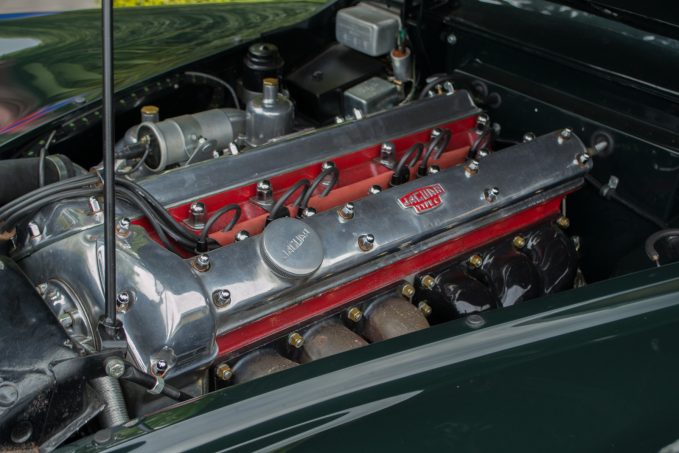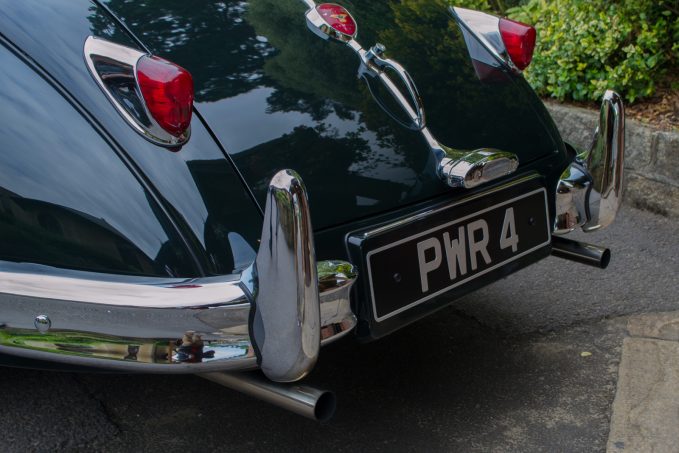I’m as nervous as I’ve been in recent memory as I release the heavy clutch and begin rolling down the road in the beautiful English countryside.
The fact that I’m not driving on the right side of the road — both literally and figuratively — is the only thing on my mind as I reach down to grab hold of the gear lever that somehow feels so normal in my left hand. I depress the clutch pedal and pull the shifter towards me, pause in neutral, and continue the rearward motion. The car shudders as I let the clutch out once more, my left foot not finessed enough for a clutch pedal that dates back to the same year Rebel Without a Cause hit the silver screen.
And that’s just the first of the 1955 Jaguar XK140’s many idiosyncrasies. The gearbox is finicky, the steering is awkward, and the slightest bump in the road can upset the car in an especially unnerving way. The brake pedal is shorter than a British-born jockey, the exhaust rattles like a can of spray paint below 2,000 rpm, and the cabin smells like a combination of clutch and high-test gasoline from time to time.
Generation Gap
Few of these quirks would be classified as charming; part of the car’s character, perhaps, but certainly not charming. In fact, at least by modern standards, there isn’t a whole lot that’s inherently good about the XK140. And yet it’s also rewarding to drive in a way that automakers today can only dream of.
Expecting any less from this car — officially a 1955 Jaguar XK140 3.4 SE Fixed Head Coupe — is as futile as its imperfections are forgivable. Beyond its strikingly beautiful and incredibly curvaceous body, this is a sports car that was built to be driven. So when Jaguar offered me an afternoon behind the wheel before the Goodwood Festival of Speed, I was quick to oblige.
I was also aware of the significance of the car I was driving. It’s not everyday you come across a British sports car more than six decades old in this condition, let alone one finished in the classic British Racing Green. Add in optional goodies like the wire wheels and dual exhaust, and it’s no wonder this XK is valued at about $120,000. While not the most valuable Jaguar of all time — that distinction belongs to the XKSS — the XK140 is worth every penny. It’s also not easily replaced.
Think of the XK140 as just one step closer in Jaguar’s sports car evolution toward the transcendent E-Type. With a 3.4-liter straight-six nestled under its elongated hood, the optional C-Type cylinder head pushed output to a claimed 210 horsepower at the flywheel — plenty of power for the day. A four-speed manual gearbox manages power transfer, and a set of drum brakes at all four corners are at your disposal when it comes time to slowly bring the Brit to a halt.
ALSO SEE: 2018 Audi RS 5 Coupe Review
Everything about the XK140 is heavy, from the clutch to the steering to the brakes, yet the gas pedal is surprisingly light. No, it won’t surprise anyone with sheer speed, but it’s certainly eager to climb through the rev range. Doing so is rewarded with a sultry sound that transcends time, all six cylinders standing rank and file, working in unison in a way no V configuration can match.
A few rough downshifts were all but unavoidable as I worked to get the hang of the non-synchromesh transmission, with the move from second to third a particular struggle as we got to know each other. But with a delicate touch, changing gears was a silky-smooth affair that brought with it a satisfaction that’s hard to find in anything on the modern market.
My long limbs betrayed me as I attempted to maneuver around the cramped cockpit, the tiny pedal box and school bus-sized steering wheel giving me all kinds of grief. Yet the steering itself was surprisingly responsive, the car quick to move in the direction it was pointed.
The Verdict: 1955 Jaguar XK140 Review
Having not driven many cars of this XK’s vintage, it was both a treat and a challenge to pilot the old coupe through the countryside. There was a need to wrestle with the XK140 somewhat early on, with fast corners and white knuckles going hand in hand, but it became surprisingly familiar as the day wore on. My nerves were also quick to settle, making way for pure joy as I cruised the narrow roads that snake their way across England.
Driving a car like this old XK will quickly make you appreciate any of the umpteen advancements offered in modern sports cars. Better brakes, suspension, and responsiveness are just some of the reasons why, say, a Jaguar F-Type is so damn good. But taking away all that character from a modern sports cars sterilizes the experience somewhat, solving
everything with equations rather than emotion. So maybe it is charming after all.










